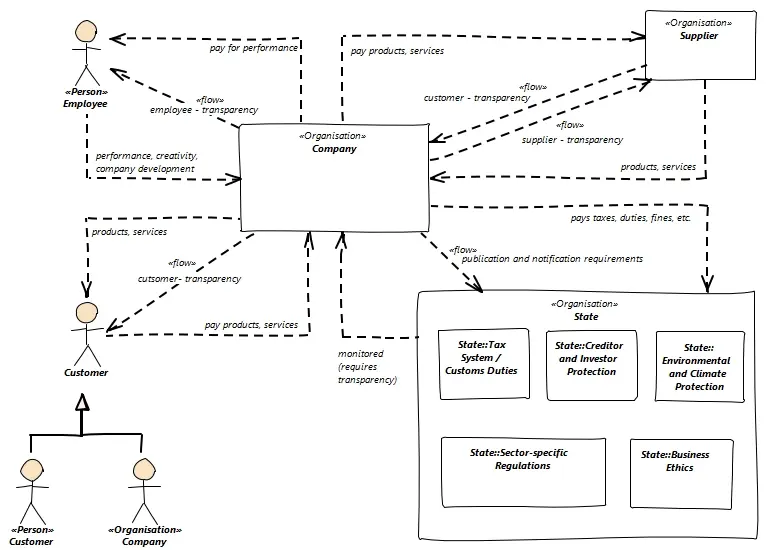Many people ask it, some Experts see it as the new golden hammer for all database tasks. Blockchain is a synonym of Distributed Ledger Technology (DLT). A DLT-System has three main components, the Ledger (Blockchain, technical a chained list), consensus algorithms, and distribution. Distribution makes it safe against manipulation; every participation holds one copy of the ledger.
Business Perspective

Companies interact at their system boundaries with different actors. The Actors include employees, customers, suppliers, and the state. Figure 1-1 shows the interaction between companies and various players. For example, employees spend their workforce and creativity and receive in exchange a compensation. Customers purchase products and services from companies. The company receives payments in return. Suppliers supply products and services to companies and receive payments for them. The state carries out sovereign tasks. In order to fulfill these tasks, states charge taxes, customs duties, or imposes fines for regulations. In order to perform its sovereign functions, the state needs insight (transparency) into the business (relationships) of a company. The obligation to the annual financial statements, as part of external accounting, serves as a basis for taxation and creditor protection (cf. Graumann, 2014, p. 249 ff.). At the system boundaries of companies, there is an increased need for transparency for all actors.
Customer
Customers like to know more about the product, supply chain (environmental awareness, ethics, e.g., no child labor). For agile companies, customer enthusiasm is an essential factor for long-term growth (cf. Hoffman & Roock, 2018, p. 13 ff.). The DM market sees itself as a community of values, which has the task to refine the consumer needs of its customers (cf. Hoffman & Roock, 2018, p. 14; Werner, 2013, p. 70).
Amazon sees itself as a customer-centric company, which expresses in a free right of return for customers. Crusade for customers is the term for this altruistic behavior at Amazon. New developments at Amazon start with a fictitious press release. The employees must first submit an idea in the form of a press release described. The aim is to formulate the customer benefit very concisely and precisely (cf. Sprenger, 2018, p. 32 ff.). In software development, we use a fictitious product carton to specified more precisely (cf. Zörner, 2012, p. 23 ff.).
Suppliers
Suppliers need transparency of internal processes to better collaborate with the company. Conceivable, at this point, is the access to specific key figures and business processes and cooperation in the development of products and services.
In Radikal Digital, Sprenger describes different views of supplier relationships. Amazon uses its market power and reduces sales prices when conditions are more favorable. This strategy Sprenger described as sales before profit. Amazon grew every year by twenty percent. Amazon uses this strategy in order to further lower the conditions (cf. Sprenger, 2018, p. 32). Sprenger sees purchasing in transition. Due to digital distribution and communication channels to the customers, he assumes that purchasing is becoming less important and that communication between companies and suppliers is gaining enormous momentum (cf. Sprenger 2018, S. 35).
Agile methods do not recommend consultants (e.g., software developers) to feel or act as suppliers. Instead is the consultant part of the team; this is called customer value, optimizing teams (Kundenwertoptimierende Teams) (cf. Hoffman & Roock, 2018, p. 49).
Supplier transparency is evaluated differently in the given examples. However, there are constellations in which manufacturers have the most significant market power in the supply chain. Examples are car manufacturers, beverage producers (Coca Cola, Pepsi), or Apple. In this case, the manufacturers dominate the distribution channels and trade.
In the authors’ opinion, a good relationship with suppliers increases the growth of their own business sustainable.
Employess
Software development employees often work with agile methods. From this follows, that employees need more transparency about internal company processes in order to be able to do their jobs. This aspect describes as a culture of continuous improvement (cf. Hoffman & Roock, 2018, p. 146 ff.). For this reason, the DM market introduced “Wertbildungsrechnung (valuation accounting)”. Werbildungsrechnung is a method to measure the valuation developed by the company with the employees. The term personnel costs were reduced by performance in order to make it clear that employees are a valuable part of the company. Werner introduces to Wertbildungsrechnung that all employees feel more and act like entrepreneurs (cf. Werner, 2013, p. 219 ff.). Employee transparency means access to critical key-figures. Critical key figures are information that conservative, managers do not like to share.
State
The state needs transparency in order to perform its tasks. Sectors like the financial industries got since the financial crisis additional regulations. Other examples are environmental and consumer protection or new regulations in labor or tax law. A Crypto-Euro does not need receipt obligation (Kassenbon-Pflicht); all payments are transparency in the ledger.
Conclusion
In summary, DLT systems are an ideal solution where trust or transparency between different actors is required. If there trust and transparency between business partners, there are still exists more efficient and mature databases. These are some thoughts on the current research of the authors and part of the MBA master thesis.
Reading recommendations DLT
- Tapscott, D & Tapscott, A. (2016). Blockchain Revolution: How the Technology Behind Bitcoin and Other Cryptocurrencies is Changing the World (1st ed.). Penguin.
- Antonopoulos, A. (2017). Mastering Bitcoin: Unlocking Digital Cryptocurrencies (2nd edition). Sebastopol, CA: O’Reilly UK Ltd.
- Antonopoulos, A. M. & Wood, D. G. (2018). Mastering Ethereum: Building Smart Contracts and DApps (1st ed.). O’Reilly Media.
Literature
- Graumann, M. (2014). Controlling: Begriff, Elemente, Methoden und Schnittstellen. (4. Aufl.). Herne: NWB Verlag.
- Hoffmann, J & Roock, S. (2018). Agile Unternehmen: Veränderungsprozesse gestalten, agile Prinzipien verankern, Selbstorganisation und neue Führungsstile etablieren (1. Aufl.). Heidelberg: dpunkt.verlag GmbH.
- Sprenger, R. K. (2018). Radikal digital: Weil der Mensch den Unterschied macht - 111 Führungsrezepte (2. Aufl.). München: Deutsche Verlags-Anstalt.
- Zörner, S. (2012). Softwarearchitekturen dokumentieren und kommunizieren: Entwürfe, Entscheidungen und Lösungen nachvollziehbar und wirkungsvoll festhalten. München: Carl Hanser Verlag GmbH & Co. KG.
